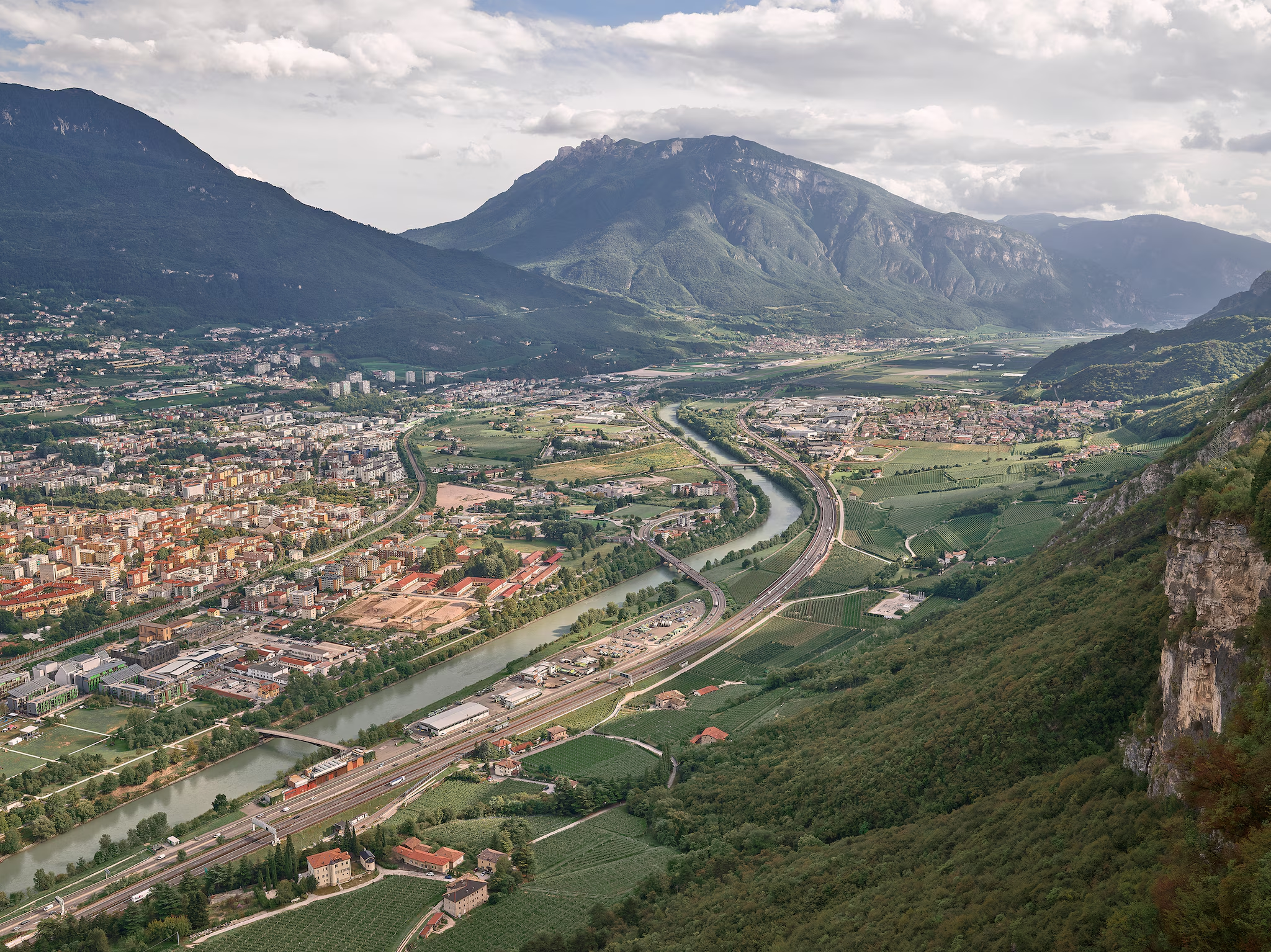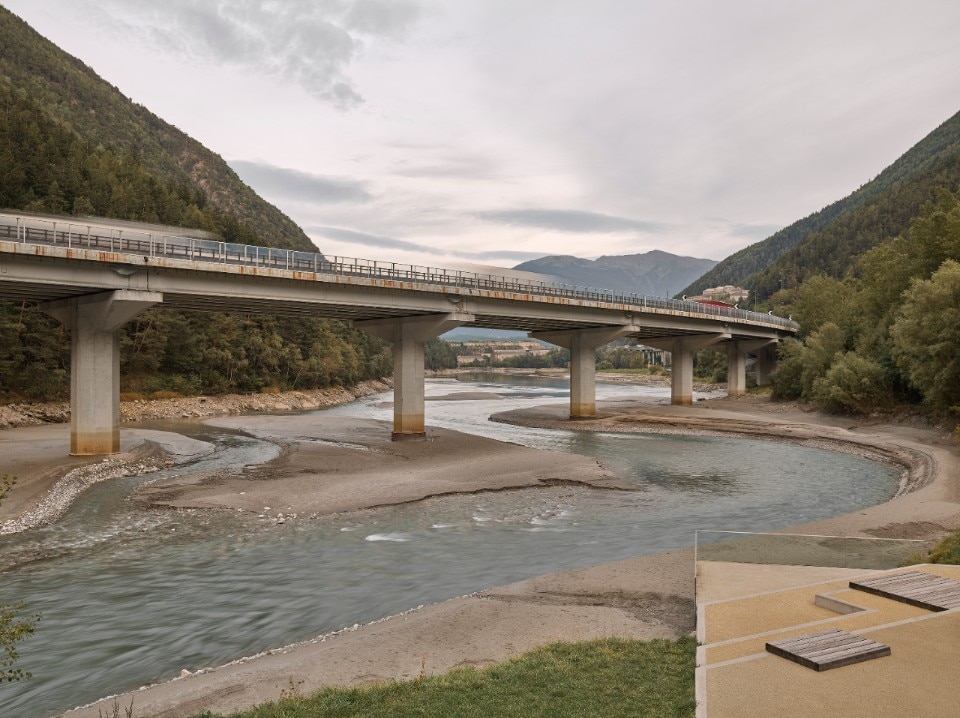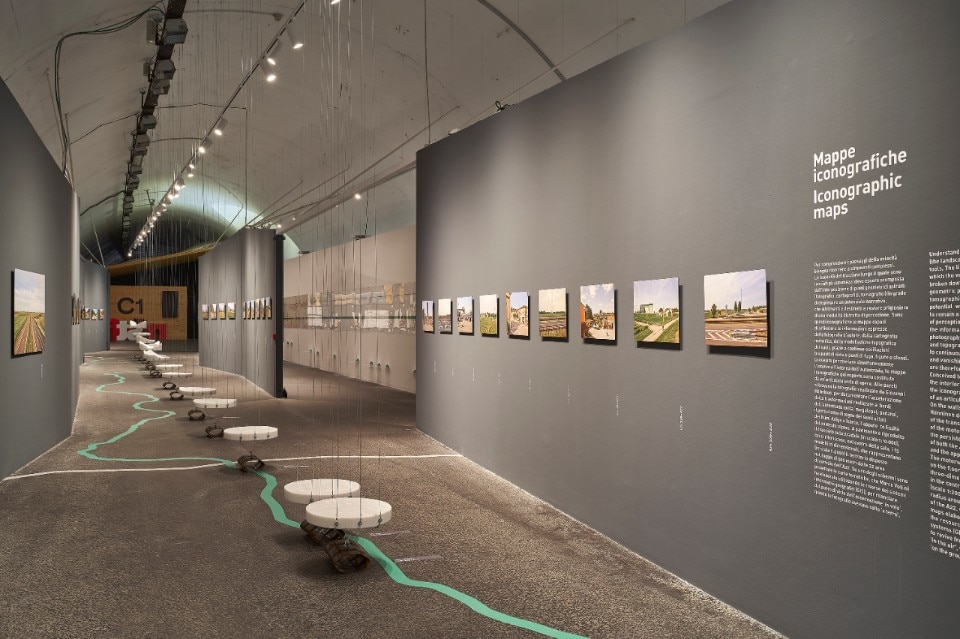
Bathed in light
Drawing from its more than 30 years of experience, SICIS introduces backlit pools in Vetrite, a patented solution that combines design, technology and function.
- Sponsored content
From the 1950s to the present day, the construction of the Italian highway network has been, perhaps more than elsewhere, a process of infrastructure development as well as the creation of imagery and narratives. A second unification of Italy was achieved along the Autostrada del Sole in 1964. The Torino-Savona, Milano-Genova, and Firenze-Mare highways became the highways of mass tourism and August traffic jams. The challenges of the Salerno-Reggio Calabria highway have come to symbolize the hopes and disappointments of the entire southern region.
Around the Alpine highways, a myth of border crossing has emerged, both in a heroic and pragmatic sense, which unites the routes that ascend the Susa Valley, the Aosta Valley, and the Friulian valleys. However, among them all, it is the Brenner Motorway, which extends from the heart of the Po Valley to the north, that best embodies the vision of an Italy projected beyond the Alps, a fully European Italy, the foreign-friendly counterpart to the Italy centered around the Autostrada del Sole.
 View gallery
View gallery

Photographs and historical drawings
1972
Campogalliano intersection
Photo Chiolini
(Autostrada del Brennero SpA)

Photographs and historical drawings
c. 1950s-60s
Preliminary layout on I.G.M. maps - Bolzano
engineer Guido De Unterrichter
(ing. Lino Gentilini Foundation)

Photographs and historical drawings
31 January 1970
Service areas. Final project for distribution along the motorways
Chorography scale 1:200,000
(Lino Gentilini Foundation)

Photographs and historical drawings
1975
Bolzano Viaduct: model cross-section
Drawing revised on the occasion of the publication of the Bolzano Viaduct in Journal of the Prestressed Concrete Institute no. 5,
September-October 1975
(ing. Lino Gentilini Foundation)

Photographs and historical drawings
1970/74
Bolzano viaduct: pier elevation at Roma bridge
(ing. Lino Gentilini Foundation)

Photographs and historical drawings
1970/74
Bolzano viaduct: detail of pile elevation
Photo G. Chiolini & C., Pavia
(ing. Lino Gentilini Foundation)

Photographs and historical drawings
1965/75
Campodazzo Viaduct: construction of deck
Photo Chiolini & C., Pavia
(ing. Lino Gentilini Foundation)

Photographs and historical drawings
2007
Campodazzo Viaduct: aerial view
Photo L. Tonina
(Autostrada del Brennero SpA)

Photographs and historical drawings
Brenner construction project
Perspective view
(ing. Lino Gentilini Foundation)

Photographs and historical drawings
1972
Campogalliano intersection
Photo Chiolini
(Autostrada del Brennero SpA)

Photographs and historical drawings
c. 1950s-60s
Preliminary layout on I.G.M. maps - Bolzano
engineer Guido De Unterrichter
(ing. Lino Gentilini Foundation)

Photographs and historical drawings
31 January 1970
Service areas. Final project for distribution along the motorways
Chorography scale 1:200,000
(Lino Gentilini Foundation)

Photographs and historical drawings
1975
Bolzano Viaduct: model cross-section
Drawing revised on the occasion of the publication of the Bolzano Viaduct in Journal of the Prestressed Concrete Institute no. 5,
September-October 1975
(ing. Lino Gentilini Foundation)

Photographs and historical drawings
1970/74
Bolzano viaduct: pier elevation at Roma bridge
(ing. Lino Gentilini Foundation)

Photographs and historical drawings
1970/74
Bolzano viaduct: detail of pile elevation
Photo G. Chiolini & C., Pavia
(ing. Lino Gentilini Foundation)

Photographs and historical drawings
1965/75
Campodazzo Viaduct: construction of deck
Photo Chiolini & C., Pavia
(ing. Lino Gentilini Foundation)

Photographs and historical drawings
2007
Campodazzo Viaduct: aerial view
Photo L. Tonina
(Autostrada del Brennero SpA)

Photographs and historical drawings
Brenner construction project
Perspective view
(ing. Lino Gentilini Foundation)
Chronologically, the Brenner Motorway is fully part of the second-generation Italian highways, those of the economic boom and subsequent growth, first robust and then progressively faltering. These highways connected the fragments of the embryonic fascist road network and enriched it with new routes and directions. They were built following the directives and funding of the Romita Law of 1955 and constructed energetically until an indefinite suspension of new construction was decided upon twenty years later, during the times of oil crises.
The Brenner Motorway connects Modena to the alpine pass from which it takes its name, passing through important cities such as Mantua, Verona, Trento, and Bolzano. Its history began in 1959 when the Autostrada del Brennero S.p.A. was founded. The final plans were approved four years later, and the entire route was completed in 1974. With its 313.5 kilometers, it is now the fifth longest highway in Italy, as well as a part of the European Route E45, which connects Scandinavia to Southern Italy.

 View gallery
View gallery
The Brenner Motorway is certainly full of bridges, viaducts, tunnels, and interchanges, some of considerable size. It was designed by excellent engineers such as the Gentilini brothers, Bruno and Lino. However, it is not a place for colossal engineering monuments in the vein of the Ponte Morandi. Its history involved excellent architects, among them Costantino Dardi – who designed the Garda Ovest service area. Nevertheless, his artistic works, in general, lack distinctive formal exuberance or sculptural power. Along its route, it does not intersect with the iconic architectural landmarks that characterize other Italian highways, such as the San Giovanni Battista church on the Autostrada del Sole by Giovanni Michelucci (1964) or the bridge-style roadside restaurants of the ‘60s and ‘70s designed by Angelo Bianchetti and Melchiorre Bega.
The weathered steel guardrails are the most recurrent and recognizable component of the highway. They are part of the landscape integration project developed by Pietro Porcinai, who was tasked with consulting on this matter. The visual identity of the infrastructure is primarily entrusted to an element that, due to its specific material and color treatment, ‘coordinates’ it with its landscape rather than setting it apart. The Brenner Motorway exists as a figure but has been seeking a close dialogue with its backdrop since its conception.
Perhaps this is precisely its main peculiarity and quality compared to many other Italian highways. Andrea Gritti, Elena Fontanella, and Claudia Zanda from the Department of Architecture and Urban Studies at the Polytechnic University of Milan, who curated the beautiful exhibition Brenner Motorway. Architectures and Landscapes at the Historical Museum Foundation of Trentino, also tell this story from this perspective.

 View gallery
View gallery

“Brenner Motorway. Architectures and landscapes”, Fondazione Museo storico del Trentino, Le Gallerie, Piazza di Piedicastello, Trento
Photo © Giovanni Hänninen

“Brenner Motorway. Architectures and landscapes”, Fondazione Museo storico del Trentino, Le Gallerie, Piazza di Piedicastello, Trento
Photo © Giovanni Hänninen

“Brenner Motorway. Architectures and landscapes”, Fondazione Museo storico del Trentino, Le Gallerie, Piazza di Piedicastello, Trento
Photo © Giovanni Hänninen

“Brenner Motorway. Architectures and landscapes”, Fondazione Museo storico del Trentino, Le Gallerie, Piazza di Piedicastello, Trento
Photo © Giovanni Hänninen

“Brenner Motorway. Architectures and landscapes”, Fondazione Museo storico del Trentino, Le Gallerie, Piazza di Piedicastello, Trento
Photo © Giovanni Hänninen

“Brenner Motorway. Architectures and landscapes”, Fondazione Museo storico del Trentino, Le Gallerie, Piazza di Piedicastello, Trento
Photo © Giovanni Hänninen

“Brenner Motorway. Architectures and landscapes”, Fondazione Museo storico del Trentino, Le Gallerie, Piazza di Piedicastello, Trento
Photo © Giovanni Hänninen

“Brenner Motorway. Architectures and landscapes”, Fondazione Museo storico del Trentino, Le Gallerie, Piazza di Piedicastello, Trento
Photo © Giovanni Hänninen

“Brenner Motorway. Architectures and landscapes”, Fondazione Museo storico del Trentino, Le Gallerie, Piazza di Piedicastello, Trento
Photo © Giovanni Hänninen

“Brenner Motorway. Architectures and landscapes”, Fondazione Museo storico del Trentino, Le Gallerie, Piazza di Piedicastello, Trento
Photo © Giovanni Hänninen
Gritti, Fontanella and Zanda define the Brenner Motorway as a ‘territorial architecture’. They analyze it as a unified yet complex and layered object. From their narrative, the highway primarily emerges as a sequence of ‘nodes’ and works of art, each with its own specific dimensions, materials, and forms. They describe it in these terms through a gallery of historical drawings and photos and a very long diagram that arranges them all in sequence. At the same time, the highway is also a ‘palimpsest within a territorial palimpsest,’ which requires investigating both ‘the inside and the surroundings.’ This aspect is addressed by thematic maps developed in GIS by Marco Voltini, highlighting the characteristics and developments of the many settlement systems it traverses; contemporary photographs by Giovanni Hänninen, which observe the motorway but also allow for exploration of its surroundings. Finally, there are 15 circular scale models at 1:2000, extending within a radius of 500 meters around each service area.
Comprising 167 sections of 3-millimeter-thick acrylic, each assembled without adhesive using threaded steel bars and suspended just a few tens of centimeters above the ground in the center of the exhibition space, these models provide the most concise overview of a landscape with multiple patterns and the ‘integration’ of the infrastructure within them. You can see it intersecting the grid of cultivated fields and brushing past the many inhabited centers of the productive plain before either settling into or distancing itself from the Alpine foothills of the Adige Valley, whose undulations become more powerful and steep, all the way to the entrance of the Isarco Valley and the final push towards the pass and beyond. Transcribed in these elegant, abstract, and diaphanous models, the Brenner Motorway seems to exist in all these landscapes as a seam rather than a scar, a delicate ‘shading’ rather than a solid filling.
- Exhibition:
- Brenner Motorway. Architectures and landscapes
- Location:
- Fondazione Museo storico del Trentino, Le Gallerie, piazza di Piedicastello, Trento (Italy)
- Dates:
- from September 29 to February 4
- Curated by:
- Andrea Gritti, Elena Fontanella and Claudia Zanda
- Photography:
- Giovanni Hänninen

The lounge moves outdoors
Pedrali presents a collection of padded outdoor furniture designed to transform exterior space into elegant and functional extensions of the home.
- Sponsored content

















